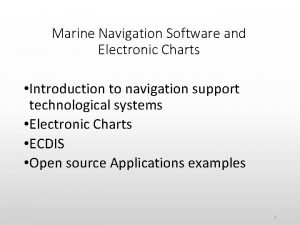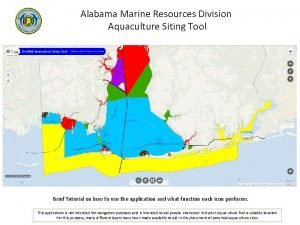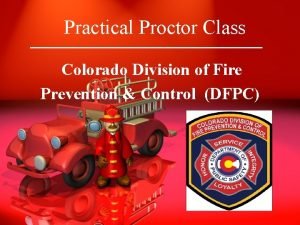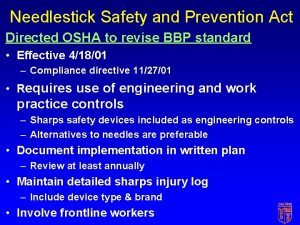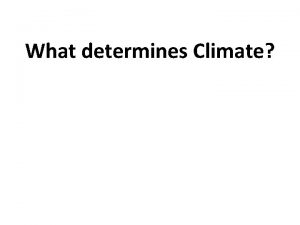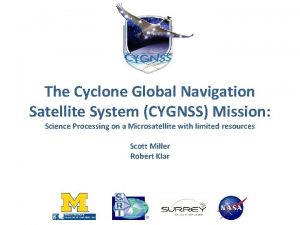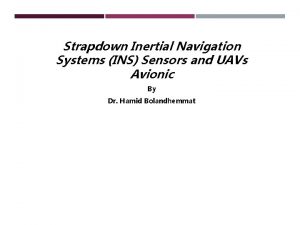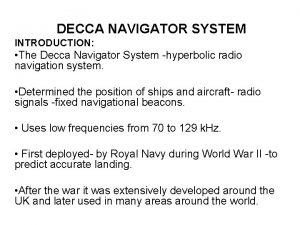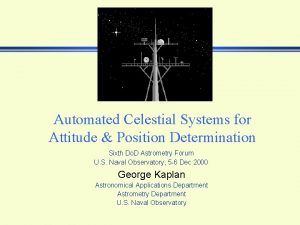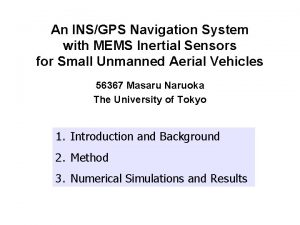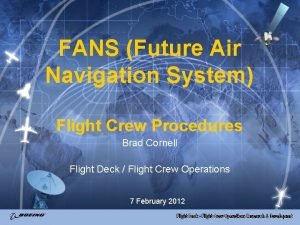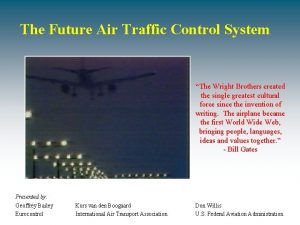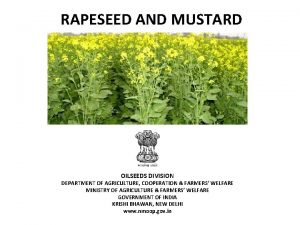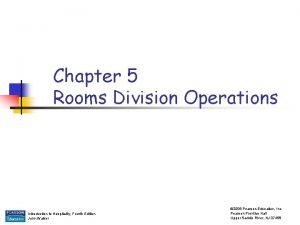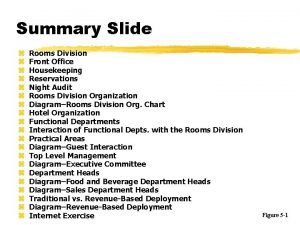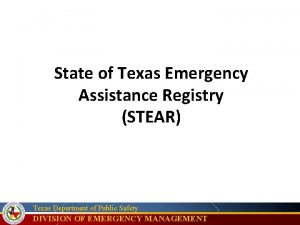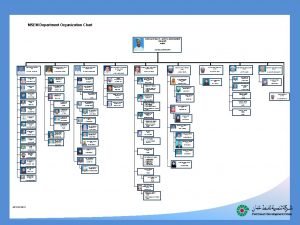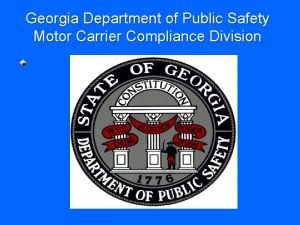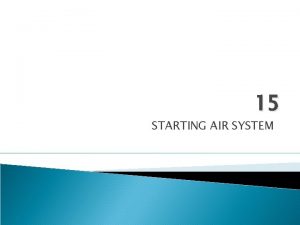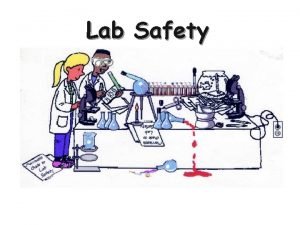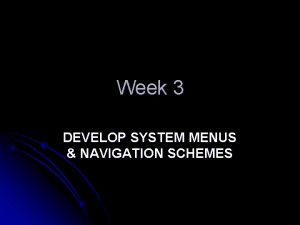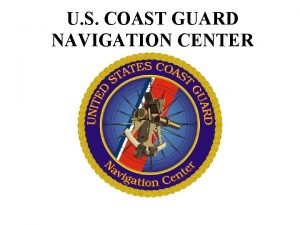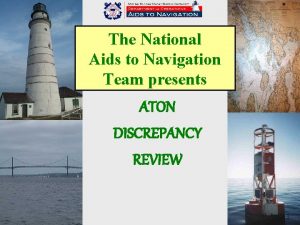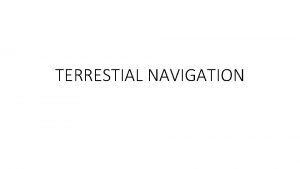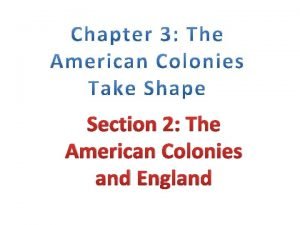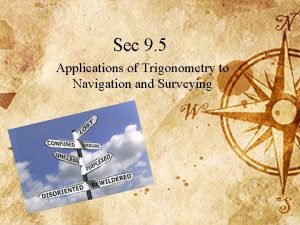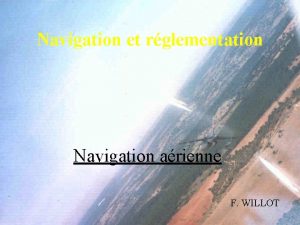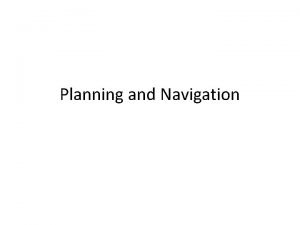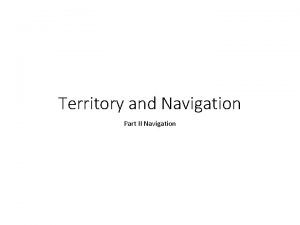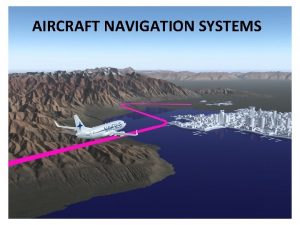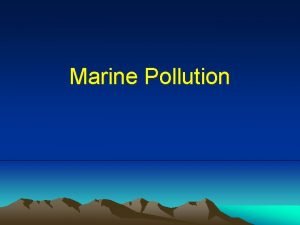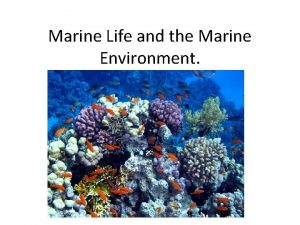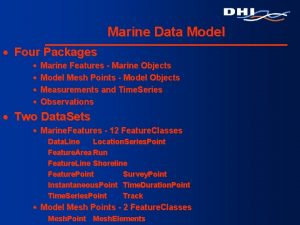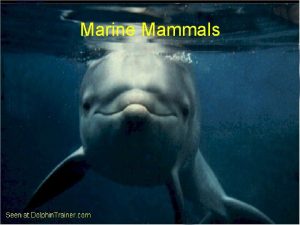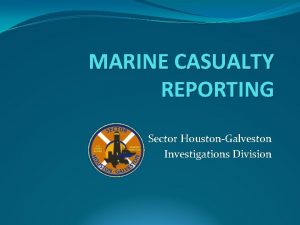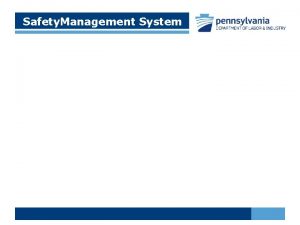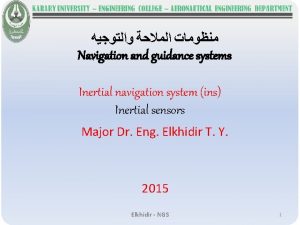Prevention Marine Safety Department Navigation System Division ALL























































- Slides: 55

Prevention (Marine Safety) Department Navigation System Division ALL ABOUT BUOYS

Buoys and Appendages

Objectives 1 Identification of buoys. 2 Familiarization with buoy appendages. 3 Identification of buoy moorings.

Buoy Classifications l The two major classes of buoys used in the Coast Guard are Ocean Buoys and River Buoys. Ocean Buoys consist of unlighted cans, nuns, and spheres, as well as sound buoys and standard lighted buoys. Standard lighted buoys are designated by IALA as pillar buoys.

Buoy Classification River buoys consist of unlighted cans and nuns with specially designed fins and counterweights.

Pillar Buoys l Cage or tower type pillar buoys are classified according to: Diameter and Length The diameter is the measured distance across the buoy body

Pillar Buoys The length is measured from the base of the buoy to the focal plane of the lantern

Cans and Nuns l 1 There are six classes of cans and nuns (1 -6) that vary according to size; class one being the largest and class six the smallest. 2 3 4 5 6

Lighted and Unlighted Buoys Letter Designations are used to describe: l SHAPE l MATERIAL that the buoy is made of. l Special DESIGN. l CHARACTERISTIC. l PURPOSE of the buoy.

Letter Designations N for Nun l C for Can l P for Plastic l F for Foam l S for Special l T for Tall l I for Ice l H for Horn l G for Gong l W for Whistle l B for Bell l L for Lighted l R for Radar Reflective l FW for Fast Water l

Serial Numbers l All buoys have serial numbers for record keeping. 9 - 89 -06 -OG 5 F- 95 -08 -GC 6 - 44 -21 2 CR- 87 -08 -CG 3 -68 -15 5 -71 -02 8 W-92 -31 -UM 4 NF-95 -25 7 I -81 -06 -AS 1 CR-52 -23 9 - 42 -21 10 -36 -02 S 3 CI-85 -42

Serial Numbers - Pillar Buoys Buoy diameter, year built, sequential number and manufacturer's code. 8 -93 -06 -XX – 8 means the buoy is eight foot in diameter. – 93 is the year built. – 06 means it was the sixth buoy built. – XX is the manufacturer’s code.



Serial Numbers - Unlighted Buoys l The serial number for unlighted steel buoys (1 st, 2 nd, 3 rd and 5 th class) and foam buoys (2 nd and 3 rd class) include: – The buoy class. – The year built. – Sequential number. – Manufacturer’s code.

Serial Numbers - Unlighted Buoys 2 CR-93 -06 -XX – 2 means it is a 2 nd class – C means it is a can shape – R means it is Radar Reflective – 93 is the year it was built – 06 means it was the sixth one built. – XX is the manufacturer’s code.

Serial Numbers - Plastic Buoys l Plastic unlighted buoys and lighted plastic discrepancy buoy serial numbers include year built and the manufacturer’s code. 5 CPR-93 -XX Is a 5 th class can, made of Plastic with a Radar Reflector, built in 1993 by manufacturer XX.

Serial Numbers - Unlighted Buoys l Foam buoys (4 th, 5 th, and 6 th class) and fast water foam buoys are marked with the buoy class, the year built, and the manufacturer’s code 4 CFR-93 -XX Is a 4 th class can, made of Foam with a Radar Reflector, manufactured in 1993 by contractor XX.

River Buoys l There are three main components that make up the design of a River Buoy. – Top - This will take the shape of a can or nun. – Body - Is designed to shed debris and is filled with polyurethane foam. – Counterweight Fin - Has multiple mooring eyes and assists the buoy in remaining vertical in a variety of fast water situations.

Buoy Nomenclature - Unlighted l There are two types of cans and nuns--Radar reflective and non-radar reflective. – When a radar reflector is added to the buoy , it takes the shape of either a can or nun

Buoy Nomenclature - Pillar l There are four main components that make up the design of a pillar buoy. Buoy tower or cage: The structure that is mounted to the buoy body and contains the signal system and identification markings of the buoy.

Buoy Nomenclature l Buoy Body: The floating platform to which all else is attached.

Battery Pockets l Battery Pockets: Hollow watertight tubes built into the buoy body that hold the batteries.

Counterweight l The weight attached to the base of the buoy body. It is designed to lower the buoy center of gravity, and allow the buoy to float in an upright position.

Lantern Guard Ring Radar Reflectors Tower Braces Battery Pockets Buoy Top Head Tower Legs Lifting Padeye Buoy Body Bottom Head Gussets Mooring Padeye Chafe Block Buoy Tube Counterweight Seat Counterweight

Vent System l The batteries used in lighted buoys require a continuous means of airflow. l Primary batteries require oxygen from the air to operate. l While secondary (solar) batteries must vent flammable hydrogen gasses.

Vent System Vent Valve Vent Line Check the vent lines and valves on these older hulls even when they are equipped with new selfcontained LED lamps. Cross Over Tube

Vent Valve Designed to seal when the buoy heels over 30º or is submerged. Reducer Valve Body Upper Valve Ball Lower Valve Ball

Battery Box l l There are single and double battery boxes. A vent valve must be installed. They may be painted the color of the buoy No air test is required.

Sound Systems l There are three main types of wave actuated sound signals: Whistle Bell Gong

Whistle is made of cast bronze and is mounted inside the cage. l As air is forced through the whistle it makes the familiar drone sound. l

BELLS Bells used on lighted and unlighted buoys and are made of a copper-silicon alloy. l External tappers impact the fixed bell when wave motion causes the buoy to roll. l

GONGS l l l Gongs are used on lighted and unlighted buoys and are made of a copper-silicon alloy. External tappers impact the fixed gongs when then buoy rolls. The gongs emit a different tone when struck thus distinguishing them from a bell.

TAPPERS l Tappers swing on hinges and strike a bell or a gong.

1962 Type Tappers l This type uses a stainless steel pin hinge and is similar to the standard adjustable tapper. (Non-Standard)

1975 Type Tapper l This type tapper is a modification of the 1962 type. The tapper balls come in various sizes and have been designed to minimize vibration. (Standard)

The Future of Sounding Aids The use of electronic charting systems will reduce the need for sounding signals in the future.

Buoy Moorings Buoy chain connects the buoy to the sinker. l The bridle distributes the load and minimizes the heel angle caused by the chain. l


Sinkers l Sinkers are used to hold buoys in position. There are two types that we use. – Concrete – Dor-mor

Sinkers Concrete - These are cheap, easy to make and easy to retrieve for an inspection. – When made, they must be cast in a single pour. – They range in size from 250 to 20, 000 lbs. – They must be marked with their actual weight.


Example of a double pour sinker.

Sinkers DOR MOR Sinker – A cast iron, pyramid shaped sinker intended for use on discrepancy buoys in areas of mud or sandy bottoms.

Shackles l Used to connect lengths of chain to bridles, sinkers, buoys and each other. Shackles range in size and are classified according to their size. With first class being the largest and fourth class the smallest. l The two types of shackles used in buoy moorings are the: split key and rivet pin.

Split-Key Shackle l Used where frequent opening of the shackle is required, such as: – Buoy to Bridle. – Bridle to Swivel. – Swivel to Chain. – Chain to Sinker. – The key is made of stainless steel and when being split apart, the angle should be between 30 and 45º.


Rivet Pin Shackle Is used for splicing chain to chain. l Using shackles in the chafe section shall be avoided. l Always install the shackle with the pin towards the sinker to prevent catching on the horse collar during mooring retrieval. l – These are also called Heat and Beat or Hot Pin shackles

SWIVELS l l l Swivels are included in the mooring and allow the buoy to twist without causing the chain to kink. They are mounted between the bridle and the riser section. They are installed with the round eye towards the bridle.

Buoy Chain Inspection When performing a mooring inspection, the entire chafe section of the mooring is brought on deck and inspected.


Buoy Chain Inspection l When performing a mooring inspection, the entire chafe section of the mooring shall be brought on deck and inspected. Inspect chain for wear by measuring the smallest parts of the most worn links using a caliper. l Inspected every 2 years, at the CO’s discretion. l

Buoy Chain Replacement l Chain moorings shall be inspected and replaced when worn to the minimum wear measurement, or when it will not last until the next mooring inspection. Any chain that is deformed, stretched, bent, or twisted, shall be replaced. l COMDTINST M 16500. 3 A shall be used to determined minimum chain wear measurements (page 2 -34)

Buoy Chain Replacement l Look for these signs in your chain:

End of the All About Buoys Orientation Session
 Primary prevention secondary prevention tertiary prevention
Primary prevention secondary prevention tertiary prevention Marine navigation software free
Marine navigation software free Aquaculture siting tool
Aquaculture siting tool Colorado jprs
Colorado jprs Name
Name Injury prevention safety and first aid
Injury prevention safety and first aid Osha needlestick protocol
Osha needlestick protocol Fire hose reel signage standards
Fire hose reel signage standards The ice cap climate type is found in __________.
The ice cap climate type is found in __________. Cyclone global navigation satellite system
Cyclone global navigation satellite system Strapdown inertial navigation system
Strapdown inertial navigation system Decca navigation system
Decca navigation system Sr 71 star tracker
Sr 71 star tracker Mems inertial navigation system
Mems inertial navigation system Fans navigation
Fans navigation Future air navigation system
Future air navigation system Work strategies global navigation system jamming
Work strategies global navigation system jamming Botanical name of mohari
Botanical name of mohari Office of academics and transformation
Office of academics and transformation Enterprise dedicated network
Enterprise dedicated network Department vs division
Department vs division Hotel rooms division organizational chart
Hotel rooms division organizational chart Room division department
Room division department Short division vs long division
Short division vs long division Synthetic division examples
Synthetic division examples Long division short division
Long division short division Synthetic divisin
Synthetic divisin Undss usg
Undss usg Texas department of public safety
Texas department of public safety Virginia department of agriculture food safety
Virginia department of agriculture food safety Ohio department of agriculture food safety
Ohio department of agriculture food safety Hse advisor adalah
Hse advisor adalah Georgia motor carrier compliance division
Georgia motor carrier compliance division Pa state police commercial vehicle safety division
Pa state police commercial vehicle safety division Inland marine transportation
Inland marine transportation Marine management system
Marine management system Main engine starting air system diagram
Main engine starting air system diagram Intrusion prevention system open source
Intrusion prevention system open source Wireless intrusion prevention system
Wireless intrusion prevention system Configure ios intrusion prevention system (ips) using cli
Configure ios intrusion prevention system (ips) using cli Host intrusion prevention system
Host intrusion prevention system What is catzoc
What is catzoc Safety care 2 person stability hold
Safety care 2 person stability hold Personal safety vs process safety
Personal safety vs process safety Safety assessment for ind safety reporting
Safety assessment for ind safety reporting Basic safety orientation
Basic safety orientation Basic safety construction site safety orientation
Basic safety construction site safety orientation Always wear safety goggles
Always wear safety goggles New and navigation schemes selection of window
New and navigation schemes selection of window What is vor navigation
What is vor navigation Us coast guard navigation center
Us coast guard navigation center What does the daytime aid to navigation mean
What does the daytime aid to navigation mean Terrestrial navigation
Terrestrial navigation Joint navigation conference
Joint navigation conference Effects of navigation acts
Effects of navigation acts Application of trigonometry in navigation
Application of trigonometry in navigation

